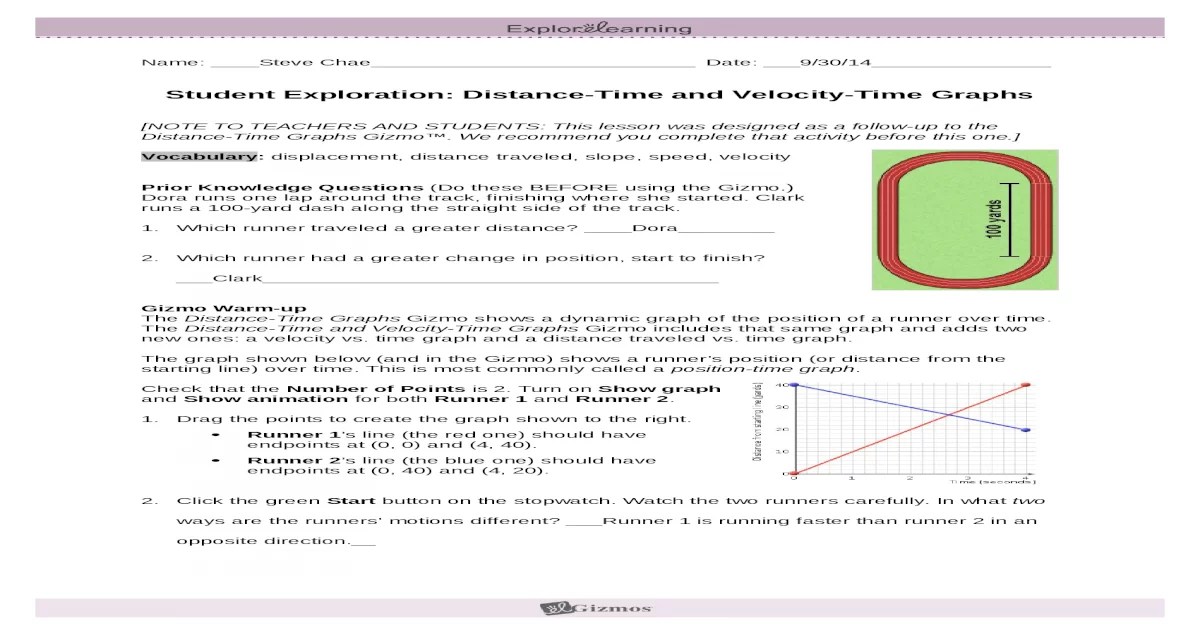Distance-time and velocity-time graphs gizmo answer key – Delve into the captivating realm of motion analysis with our comprehensive guide to distance-time and velocity-time graphs. This indispensable resource unveils the secrets of these graphical representations, empowering you to decipher the intricate dance of objects in motion.
Through a meticulous exploration of distance-time graphs, we unravel their ability to depict an object’s journey, revealing its distance traveled and velocity at any given instant. Velocity-time graphs, on the other hand, unveil the dynamics of motion, providing insights into an object’s velocity and acceleration over time.
Distance-Time Graphs
Distance-time graphs are graphical representations of the motion of an object. They plot the distance traveled by an object on the y-axis against the time taken on the x-axis. These graphs provide a visual representation of the object’s motion and allow us to analyze its speed and acceleration.
There are different types of distance-time graphs, each representing a specific type of motion. A linear distance-time graph indicates that the object is moving with constant velocity, while a curved distance-time graph indicates that the object is accelerating.
By interpreting distance-time graphs, we can determine the distance traveled by the object and its velocity at any given time. The slope of the graph represents the velocity of the object, and the area under the graph represents the total distance traveled.
Velocity-Time Graphs
Velocity-time graphs are graphical representations of the velocity of an object over time. They plot the velocity of an object on the y-axis against the time taken on the x-axis. These graphs provide a visual representation of the object’s motion and allow us to analyze its acceleration.
There are different types of velocity-time graphs, each representing a specific type of motion. A horizontal velocity-time graph indicates that the object is moving with constant velocity, while a sloping velocity-time graph indicates that the object is accelerating.
By interpreting velocity-time graphs, we can determine the velocity of the object at any given time and its acceleration. The slope of the graph represents the acceleration of the object, and the area under the graph represents the total displacement of the object.
Relationship between Distance-Time and Velocity-Time Graphs

Distance-time and velocity-time graphs are closely related and can be used together to analyze the motion of an object. The distance-time graph provides information about the distance traveled by the object, while the velocity-time graph provides information about the velocity of the object.
By combining the information from both graphs, we can gain a complete understanding of the object’s motion. For example, we can determine the average velocity of the object by calculating the slope of the distance-time graph and the instantaneous velocity of the object at any given time by calculating the slope of the velocity-time graph.
Applications of Distance-Time and Velocity-Time Graphs: Distance-time And Velocity-time Graphs Gizmo Answer Key
Distance-time and velocity-time graphs have a wide range of applications in various fields, including physics, engineering, and sports.
In physics, these graphs are used to analyze the motion of objects and to solve problems related to kinematics. In engineering, these graphs are used to design and optimize the performance of machines and vehicles. In sports, these graphs are used to analyze the performance of athletes and to improve training techniques.
Overall, distance-time and velocity-time graphs are powerful tools that can be used to analyze and understand the motion of objects.
FAQ Corner
What is the purpose of a distance-time graph?
Distance-time graphs depict an object’s motion by plotting its distance traveled against time, providing a visual representation of its journey.
How can I determine an object’s velocity from a velocity-time graph?
The slope of a velocity-time graph represents the object’s velocity at any given instant.
What is the relationship between distance-time and velocity-time graphs?
Distance-time graphs can be derived from velocity-time graphs by integrating the velocity-time graph with respect to time.